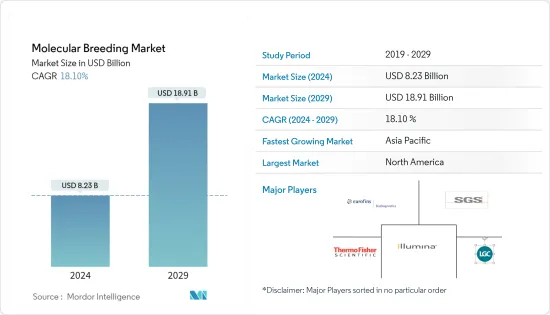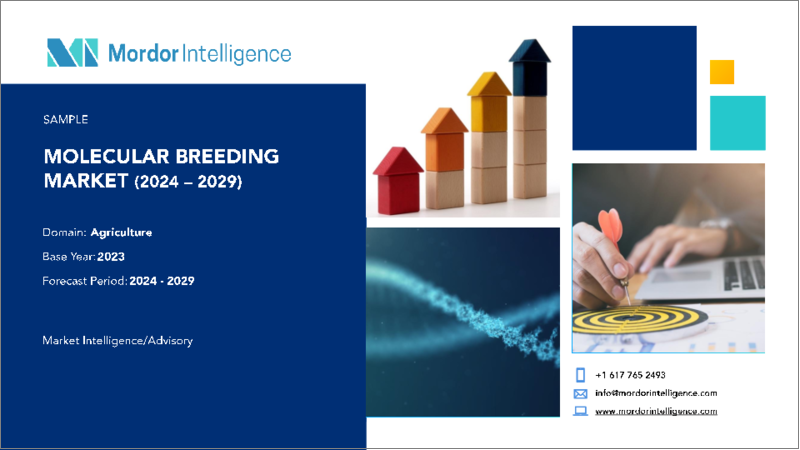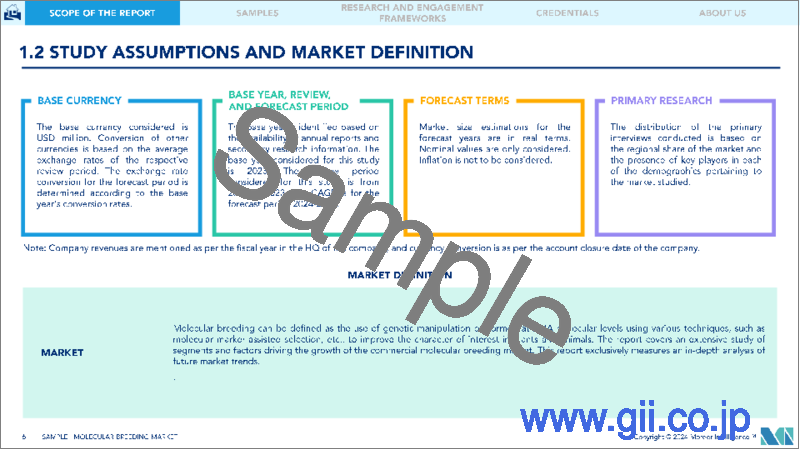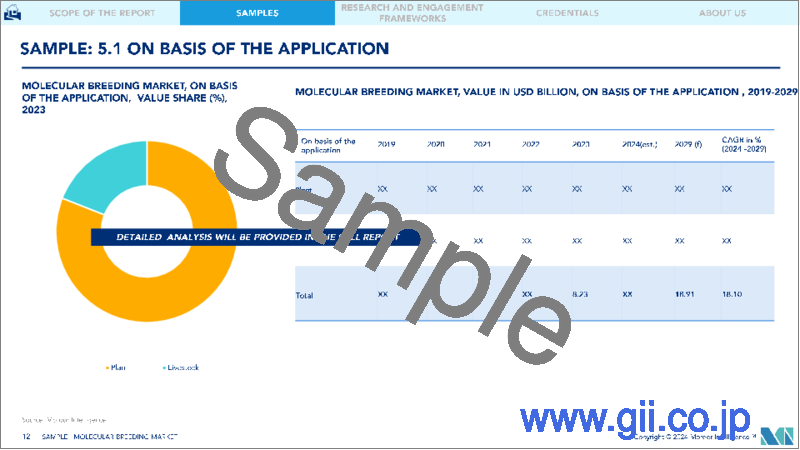|
|
市場調査レポート
商品コード
1433941
分子育種- 市場シェア分析、産業動向・統計、成長予測(2024~2029年)Molecular Breeding - Market Share Analysis, Industry Trends & Statistics, Growth Forecasts (2024 - 2029) |
||||||
カスタマイズ可能
適宜更新あり
|
|||||||
| 分子育種- 市場シェア分析、産業動向・統計、成長予測(2024~2029年) |
|
出版日: 2024年02月15日
発行: Mordor Intelligence
ページ情報: 英文 80 Pages
納期: 2~3営業日
|
全表示
- 概要
- 目次
分子育種市場規模は2024年に82億3,000万米ドルと推定され、2029年までに189億1,000万米ドルに達すると予測されており、予測期間(2024年から2029年)中に18.10%のCAGRで成長します。

新しい作物の品種を開発するプロセスには、ほぼ20~25年かかりますが、バイオテクノロジーを使用することで、この期間をほぼ7~8年に短縮できます。マーカー支援選抜(MAS)などのツールを使用すると、科学者はより生産的な結果が得られる植物形質をより簡単かつ迅速に選択できます。分子育種技術は初期段階にあります。オランダと英国では、新品種の作物に分子育種技術が100%採用されています。種子会社の主要企業は、種子品種の改良のためにこれらの技術を採用しています。遺伝子部門と調査部門の価格の低下は市場の改善につながります。公共部門だけでなく民間部門からも資金が、畑や野菜作物におけるゲノム選抜やMASの応用などの植物育種や遺伝子調査に向けて流れており、将来的には市場が活性化するでしょう。分子育種市場は、予測期間中にアジア太平洋地域で最も成長すると予測されています。
分子育種市場の動向
トウモロコシの生産量が飛躍的に増加
食料生産と消費に対する世界の需要は急速に増加しています。米国の平均トウモロコシ収量は、20世紀前半の1.6トン/ヘクタールから約9.5トン/ヘクタールまで増加しました。劇的な収量の向上は、ハイブリッドコーン、合成肥料の使用、および分子育種市場を推進する新しい農法の採用によるものです。分子育種形質のイントロダクションとDNAベースのマーカーを使用した新しい育種技術の開発により、分子育種の新しい革新的な市場が生み出されました。たとえば、今後20年間で、バイオテクノロジー形質とマーカー支援育種により、米国のトウモロコシの収量が2倍になる可能性があります。
北米が最大のシェアを占める
2017年の分子育種市場では北米が最大のシェアを占め、分子育種の利点について農家の間で認識が高まっており、小麦とトウモロコシの生産高が高かったため欧州がそれに続いたが、これにより将来的には市場が広がることになると思われます。市場。米国とカナダ、それに続く欧州における大手企業の存在により、分子育種市場の採用が増加しています。アジア太平洋地域の分子育種市場は、インド、中国、タイなどの主要企業からの投資の増加により、最も高い率で成長すると予測されています。
分子育種産業の概要
分子育種市場は高度に細分化されており、大手企業は市場に足跡を残すために、製品の価格分析、新製品開発、買収と合併、拡大、パートナーシップなどの多くの戦略を採用してきました。シンジェンタのような大手企業は、「サーモフィッシャーサイエンティフィック」の高度に修正されたジェノタイピングプラットフォームを使用して、育種パイプラインに必要なデータを提供し、より優れた収量の可能性を持つ新品種を迅速に選択します。
その他の特典
- エクセル形式の市場予測(ME)シート
- 3か月のアナリストサポート
目次
第1章 イントロダクション
- 調査の成果
- 調査の前提
- 調査範囲
第2章 調査手法
第3章 エグゼクティブサマリー
第4章 市場力学
- 市場概要
- 市場促進要因と市場抑制要因のイントロダクション
- 市場促進要因
- 市場抑制要因
- 業界の魅力度-ポーターのファイブフォース分析
- 新規参入業者の脅威
- 買い手/消費者の交渉力
- 供給企業の交渉力
- 代替品の脅威
- 競争企業間の敵対関係の強さ
第5章 市場セグメンテーション
- 用途別
- 植物
- 家畜
- マーカー別
- 単純配列反復
- 一塩基多型
- 発現配列タグ
- その他
- 分子育種プロセス
- マーカーアシスト選抜
- QTLマッピング
- マーカーアシスト戻し交配
- 地域別
- 北米
- 米国
- カナダ
- メキシコ
- その他北米地域
- 欧州
- ドイツ
- 英国
- フランス
- ロシア
- スペイン
- その他欧州
- アジア太平洋
- 中国
- 日本
- インド
- 韓国
- その他アジア太平洋
- 世界のその他の地域
- 北米
第6章 競合情勢
- 最も採用されている戦略
- 市場シェア分析
- 企業プロファイル
- Illumina
- LGC Limited
- Thermo Fisher Scientific
- SGS
- LemnaTec
- Charles River
- DanBred
- Intertek
- Eurofins
第7章 市場機会と今後の動向
The Molecular Breeding Market size is estimated at USD 8.23 billion in 2024, and is expected to reach USD 18.91 billion by 2029, growing at a CAGR of 18.10% during the forecast period (2024-2029).

The process of developing new crop varieties almost takes around 20- 25 years but this time limit can be shortened to almost 7-8 years by using biotechnology. Tools like marker-assisted selection (MAS) make it easier and faster for the scientist to select plant traits with more productive results. Molecular breeding technology is in the nascent stage. Netherland and UK witnessed 100% adoption of molecular breeding techniques for new crop variety. Major players in seed companies have been adopting these technologies for improvement in seed varieties. The decline of prices in the genetic and research departments leads to the improvement of the market. Funds flow from private as well as public sectors towards plant breeding and genetic research such as genomic selection in field and vegetable crops and application of MAS will gear up the market in the future. The molecular breeding market is projected to grow highest in the Asia-Pacific region during the forecast period.
Molecular Breeding Market Trends
Increase in production of Corn exponentially
Global demand for food production and consumption increasing at a rapid pace. U.S. average corn yield has increased from 1.6tonnes/hectare in the first half of the 20th century to approximately 9.5tonnes/ha. The dramatic yield improvement is due to the use of hybrid corn, synthetic fertilizers, and the adoption of new farm practices that drives the molecular breeding market. Introduction of molecular breeding traits and development of new breeding technology using DNA based markers created a new and innovative market for molecular breeding. For instance, Over the next two decades, biotechnology traits and marker-assisted breeding have the potential to double the corn yields in the U.S.
North America account for largest share
North America accounted for the largest share in the molecular breeding market in 2017, followed by Europe due to high yield in the production of wheat and maize as awareness among the farmers about the benefits of molecular breeding are increasing which will create a scope in the future market. The presence of major companies in US and Canada followed by Europe has resulted in increasing adoption of the molecular breeding market. The Molecular breeding market in the Asia-Pacific region is projected to grow with highest rate due to increasing investment from the key players in countries such as India, China, and Thailand.
Molecular Breeding Industry Overview
The molecular breeding market is highly fragmented and major players have used many strategies such as pricing analysis of the product, new product development, acquisition and mergers, expansion, the partnership to make a footprint in the market. Major players like Syngenta using advance modified genotyping platforms from "Thermo Fisher Scientific" to provide necessary data for the breeding pipeline to quickly select the new varieties with much better yield potential.
Additional Benefits:
- The market estimate (ME) sheet in Excel format
- 3 months of analyst support
TABLE OF CONTENTS
1 INTRODUCTION
- 1.1 Study Deliverables
- 1.2 Study Assumptions
- 1.3 Scope of the Study
2 RESEARCH METHODOLOGY
3 EXECUTIVE SUMMARY
4 MARKET DYNAMICS
- 4.1 Market Overview
- 4.2 Introduction to Market Drivers and Restraints
- 4.3 Market Drivers
- 4.4 Market Restraints
- 4.5 Industry Attractiveness - Porter's Five Force Analysis
- 4.5.1 Threat of New Entrants
- 4.5.2 Bargaining Power of Buyers/Consumers
- 4.5.3 Bargaining Power of Suppliers
- 4.5.4 Threat of Substitute Products
- 4.5.5 Intensity of Competitive Rivalry
5 MARKET SEGMENTATION
- 5.1 On basis of application
- 5.1.1 Plant
- 5.1.2 Livestock
- 5.2 On basis of marker
- 5.2.1 Simple sequence repeat
- 5.2.2 Single nucleotide polymorphism
- 5.2.3 Expressed sequence tags
- 5.2.4 Others
- 5.3 On basis of molecular breeding process
- 5.3.1 Marker assisted selection
- 5.3.2 QTL Mapping
- 5.3.3 Marker assisted back crossing
- 5.4 Geography
- 5.4.1 North America
- 5.4.1.1 United States
- 5.4.1.2 Canada
- 5.4.1.3 Mexico
- 5.4.1.4 Rest of North America
- 5.4.2 Europe
- 5.4.2.1 Germany
- 5.4.2.2 United kingdom
- 5.4.2.3 France
- 5.4.2.4 Russia
- 5.4.2.5 Spain
- 5.4.2.6 Rest of Europe
- 5.4.3 Asia Pacific
- 5.4.3.1 China
- 5.4.3.2 Japan
- 5.4.3.3 India
- 5.4.3.4 South Korea
- 5.4.3.5 Rest of Asia-Pacific
- 5.4.4 Rest of World
- 5.4.1 North America
6 COMPETITIVE LANDSCAPE
- 6.1 Most Adopted Strategies
- 6.2 Market Share Analysis
- 6.3 Company Profiles
- 6.3.1 Illumina
- 6.3.2 LGC Limited
- 6.3.3 Thermo Fisher Scientific
- 6.3.4 SGS
- 6.3.5 LemnaTec
- 6.3.6 Charles River
- 6.3.7 DanBred
- 6.3.8 Intertek
- 6.3.9 Eurofins






